Guitar tablature, commonly known as “guitar tabs,” is a game-changer for aspiring guitarists. It’s a simple and effective way to notate music, allowing beginners to dive into playing songs much faster than with traditional sheet music. While guitar tabs share some similarities with standard music notation—showing notes, rhythm, and techniques—they have a significant advantage: guitar tabs tell you exactly where to play the notes on the guitar neck.
This is incredibly helpful because the guitar fretboard allows you to play the same note in multiple locations. For beginners especially, understanding and Reading Guitar Tabs is a shortcut to learning guitar. You can start playing your favorite songs without the initial hurdle of learning to read standard musical notation.
At guitarplayers.net, we recognize the power of guitar tabs. We believe learning how to read guitar tabs is essential because it’s the quickest route to playing both chords and individual notes. It removes much of the initial complexity of learning guitar, requiring only a basic understanding of your guitar’s strings and frets.
Ready to unlock the world of guitar tabs? Let’s explore what guitar tabs are, how they work, and how they can get you playing your favorite tunes in no time.
What Exactly Are Guitar Tabs?
Guitar tablature is a visual representation of music specifically designed for guitar. Think of it as a guitar-centric language for music. A standard guitar tab is made up of six horizontal lines. Each line corresponds to one of the six strings on your guitar. When you read guitar tabs, you read them from top to bottom, just like you look at your guitar when you hold it. The top line represents the high E string (the thinnest string), and the lines below it represent the B, G, D, A, and low E strings (the thickest string), in that order.
Imagine guitar tablature as your personal roadmap to musical success on the guitar. It provides a clear and direct path for learning songs quickly and efficiently.
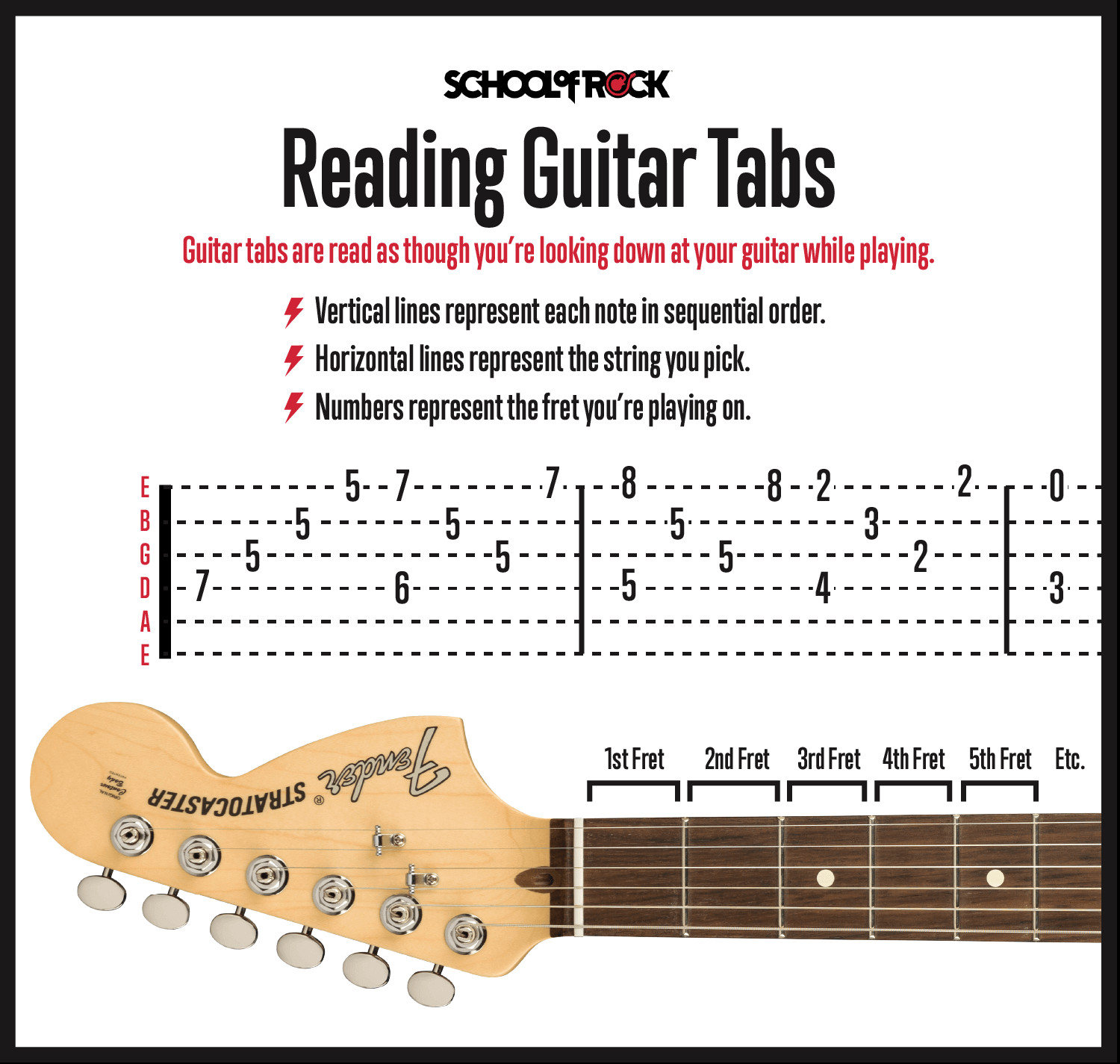 Visual representation of guitar tabs showing strings
Visual representation of guitar tabs showing strings
Within these six lines, you’ll notice numbers. These numbers are crucial – they represent the frets on your guitar. Frets are the metal strips running across your guitar’s fretboard. They are numbered from 0 upwards, starting at the nut (the white piece near the headstock) and extending down the guitar neck.
When you see a “0” on a string line in a guitar tab, it means play that string “open,” meaning you pluck or pick the string without pressing down any frets with your fretting hand. If you see a “1,” it indicates that you should play the note at the first fret on that string. Continuing this pattern, “2” means the second fret, “3” the third fret, and so on. As you learn how to read guitar tabs, remember this simple number-to-fret correspondence: each number directly tells you which fret to use.
Decoding Guitar Tabs: A Step-by-Step Guide
Reading guitar tabs is straightforward. You read them from left to right, just like reading words in a book. The notes are presented in the order they are played in the song. When you see numbers stacked vertically on top of each other across multiple lines, this indicates a chord. A chord is played by strumming all the strings indicated by those vertical numbers at the same time.
Guitar tab notation is often considered more accessible for beginners than standard music notation. It clearly shows you which notes to play to form a chord and, crucially, where to play them on your guitar fretboard.
Essential Knowledge for Reading Guitar Tabs Effectively
To successfully read guitar tabs and translate them into music, beginners need to familiarize themselves with two key elements of the guitar:
- The 6 Strings: Knowing the name and order of the strings (E, B, G, D, A, E from thinnest to thickest) is fundamental.
- Fret Locations: Understanding the fret numbers and their positions along the neck is equally important.
With these two pieces of knowledge, you can use guitar tabs as a guide to find the correct notes and play songs.
Understanding the Guitar Tab Staff: Strings, Not Notes
The guitar tab staff visually resembles the staff used in standard notation. However, a critical difference is that the lines in guitar tab represent the six guitar strings, not musical notes in the traditional sense.
As mentioned earlier, the top line is the high E string, and the bottom line is the low E string. This direct string representation is what makes learning how to read guitar tabs so beginner-friendly. To avoid confusion with standard notation, guitar tabs are typically labeled “TAB” clearly at the beginning of the staff.
Exploring Guitar Frets in Tablature
Guitar frets, those metal strips across the fretboard, are the foundation of pitch on the guitar.
Most guitars feature between 19 and 24 frets. The distance between each fret represents one semitone, or half step, in musical terms. There are 12 semitones in each octave. To help navigate the fretboard, most guitars have fret markers—inlays or dots—typically positioned at the 3rd, 5th, 7th, 9th, and 12th frets. These markers are visual aids to quickly identify fret positions while playing.
Remember, in guitar tabs, fretted strings are indicated by numbers corresponding to the fret number. An open string, played without fretting, is represented by the number “0”. Playing an open string simply involves picking or plucking the string and letting it ring out freely.
Mastering Guitar Tab Chords: Vertical Harmony
Guitar chords in tablature don’t have any special symbols. Instead, they are easily identified by their positioning within the tab. When you see several numbers aligned vertically in a column, it signifies a chord. These vertically aligned notes are meant to be played together, creating harmonic richness.
Even if a chord is arpeggiated—meaning the notes of the chord are played individually rather than strummed together—it will still be represented by the same fret numbers, just presented as single notes played in sequence.
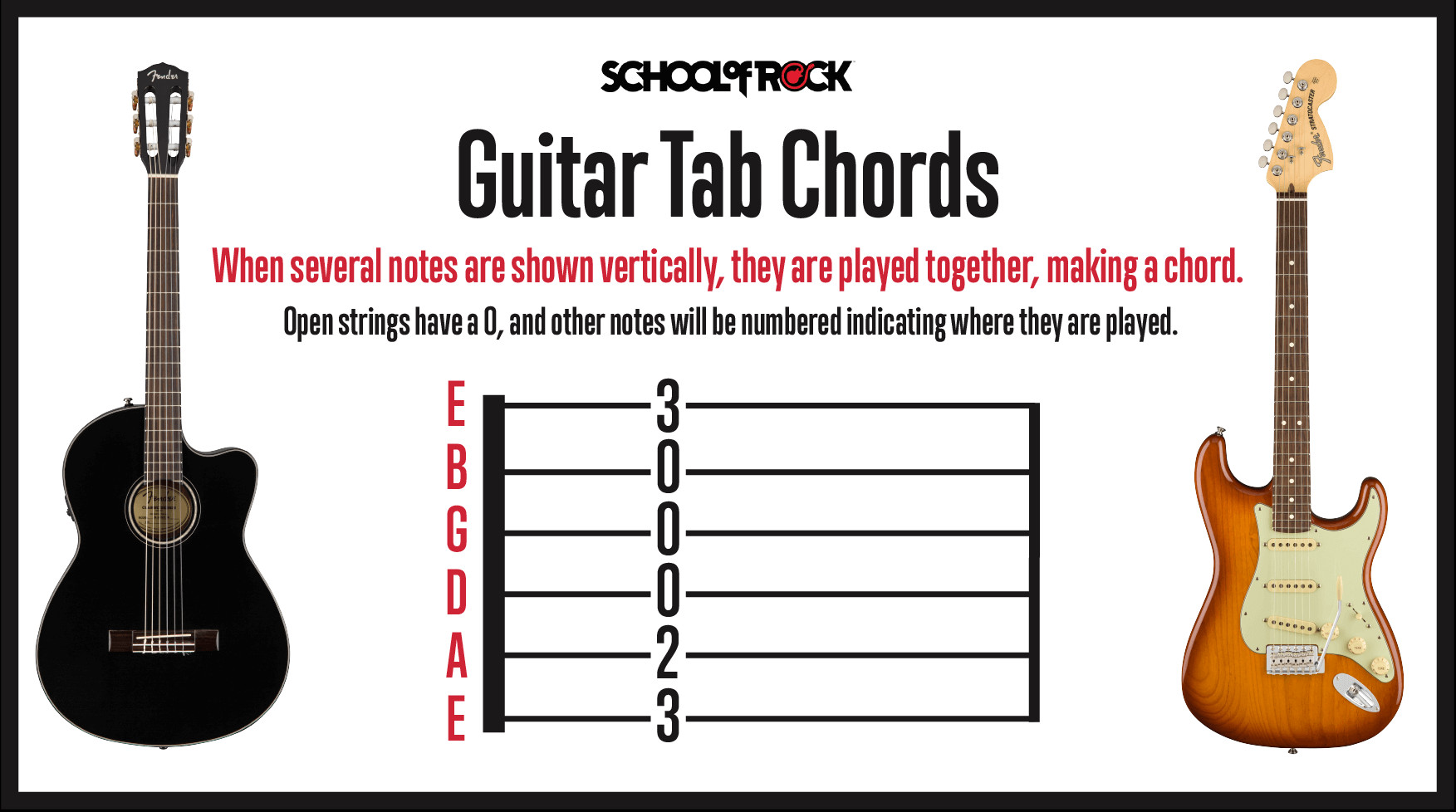 Example of guitar tab chords with vertical note alignment
Example of guitar tab chords with vertical note alignment
Reading Guitar Tab Riffs: Melodic Patterns
Many rock songs, and songs in other genres, are built around “riffs.” Riffs are essentially short, repeated musical phrases, often a combination of single notes and partial chords, such as power chords. When reading guitar tabs for riffs, the same principles apply: if two or more notes are vertically aligned, they are played at the same time. This consistent notation makes learning how to read guitar tablature and play riffs both quick and intuitive.
Guitar Tabs vs. Chord Charts: Understanding the Difference
Guitar tabs and chord charts serve different but complementary purposes in guitar learning. A chord chart is a visual diagram that illustrates where to place your fingers on the fretboard to form a specific chord. Chord charts also often indicate which fingers to use for each string. They are frequently included above song lyrics to show chord changes in songbooks and online resources.
Chord charts are focused on the essential 3 to 4 notes that constitute a basic chord. However, a full and nuanced guitar part in a song might involve single notes, notes outside the basic chord, or arpeggios. These details are not captured in a chord chart alone. For this reason, chord charts are often used alongside guitar tabs, especially for beginners. Chord charts help guitarists grasp the fundamental chord shapes, while tabs provide the detailed musical information needed to play a song accurately.
Finger Numbers in Chord Charts: A Quick Guide (Note: Not Used in Tabs)
Chord charts utilize a numbering system to indicate which fingers of your fretting hand should be used to play each note in a chord. The fingers are numbered as follows:
- 1: Index finger
- 2: Middle finger
- 3: Ring finger
- 4: Pinky finger
It’s important to note that this finger numbering system is specific to chord charts and is not used in guitar tabs. In tabs, the numbers represent frets, not fingers. Chord charts are sometimes included with easy guitar tabs to guide beginners on hand positioning for chords.
Guitar Tab Symbols and Techniques: Beyond the Basics
Beyond numbers and lines, guitar tabs use various symbols to indicate specific guitar techniques. Learning to recognize and apply these symbols is crucial for playing guitar parts authentically and making reading guitar tabs even more rewarding.
Before diving into techniques, always ensure your guitar is properly tuned. Guitar tuning is fundamental, and playing with an out-of-tune guitar will negatively impact your sound, regardless of how accurately you read the tab.
Muting Guitar Notes: Adding Dynamics and Style
Muting is a vital technique, particularly in rock music and genres like heavy metal, punk, and alternative. Different muting techniques are used to create specific sounds and rhythmic character.
How Guitar Notes are Muted
Muting can be achieved with either your picking hand, your fretting hand, or both. Primarily, it’s done with the picking hand. Muting adds dynamic variation to your playing. In songs, verses may be muted while choruses or hooks are played without muting to create contrast.
Experienced guitarists often use muting instinctively, especially when playing at higher volumes. Muting helps eliminate unwanted noise and feedback, resulting in a cleaner and more controlled sound.
Palm Muting (P.M.): The Rock Guitar Staple
Palm muting is an extremely common technique in rock guitar and many other genres. It’s executed by lightly resting the palm of your picking hand on the strings near the bridge while picking. The pressure from your palm dampens the strings, creating a characteristic muted tone. Heavy palm muting produces a tight, percussive sound, while lighter palm muting allows the notes to ring out slightly more. In guitar tabs, palm muting is indicated by “P.M.” written above the section of tab where it should be applied.
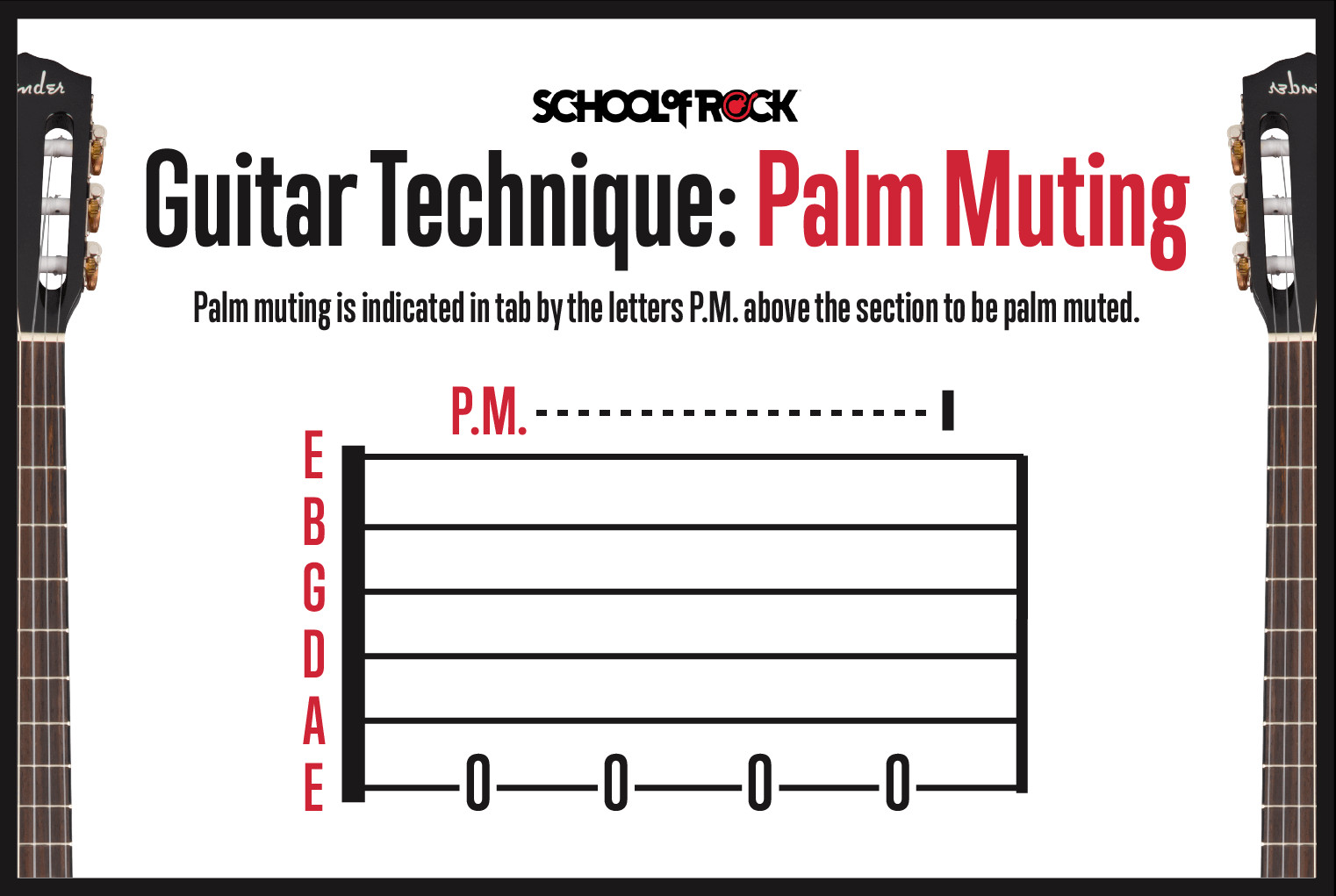 Guitar technique palm muting demonstration
Guitar technique palm muting demonstration
Muted Notes (X): Fretting Hand Muting
Muted notes are a different technique from palm muting. They are achieved by using your fretting hand to lightly touch the strings without pressing them down fully to the fretboard. In guitar tabs, muted notes are represented by an “X” in place of a fret number. You still pick the string, but the fretting hand muting prevents a clear, distinct pitch from ringing out. Instead, you get a percussive, muted sound.
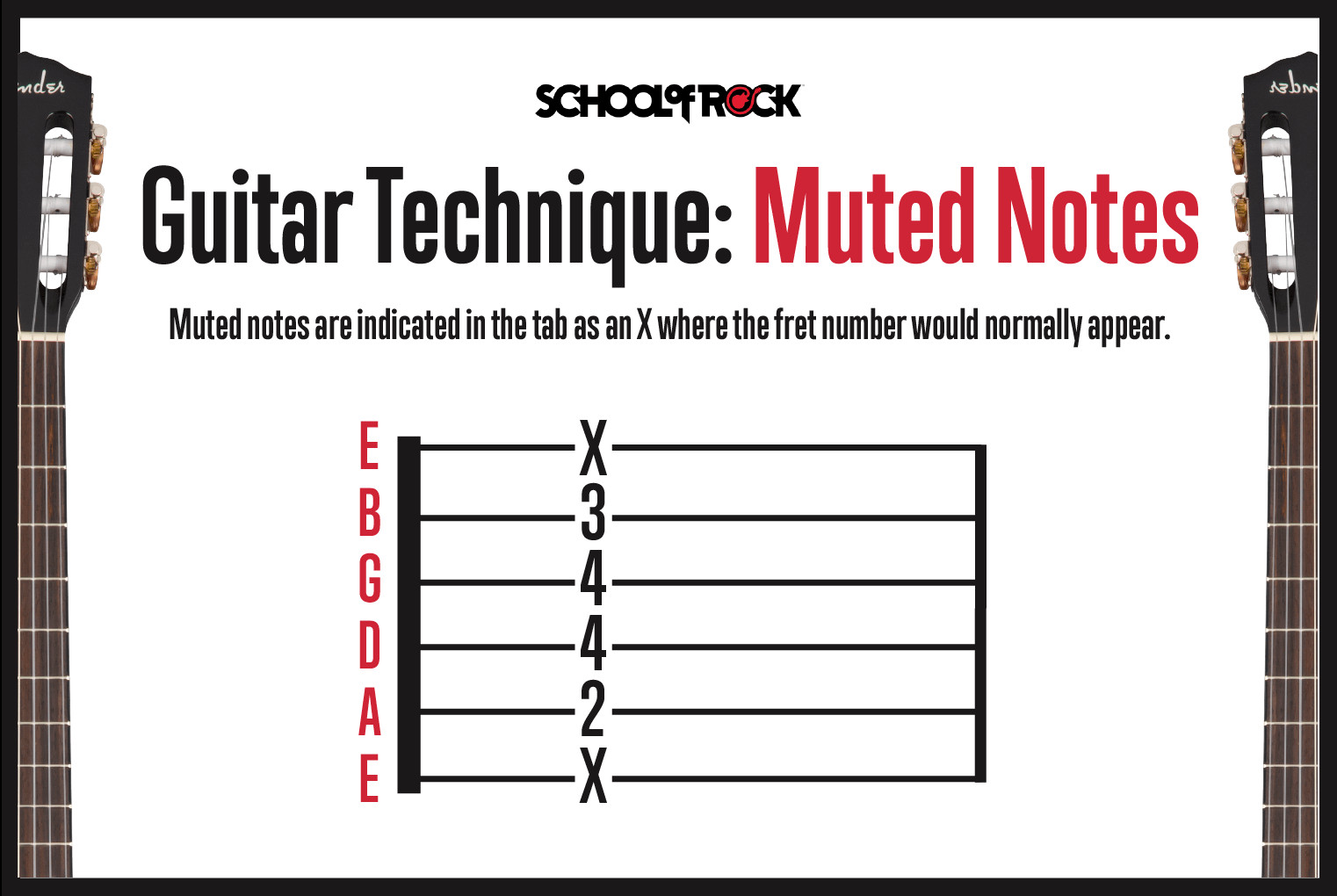 Guitar technique muted notes demonstration
Guitar technique muted notes demonstration
Bending Guitar Strings: Adding Vocal Expression
String bending is a technique that adds expressive, vocal-like qualities to guitar playing. In guitar tabs, bends are indicated by a curved arrow above the note to be bent. The arrow shows the direction of the bend and often includes an indication of the bend’s extent, such as “½” for a half step bend or “full” for a full step bend. These target pitches are often referred to as “target notes.”
How to Execute String Bends
Bending is done by pushing or pulling the string sideways across the fretboard, rather than pressing straight down onto the fret. For most strings (except the low E), you push the string upwards towards the ceiling. The low E string is typically bent downwards towards the floor. The key to a good bend is applying smooth, consistent pressure to the string as you bend it to the desired pitch.
Refining Bending Technique
Most bends are performed using a combination of fingers. The “main” fretting finger (often the ring finger) is used to bend the string, while the middle and index fingers are positioned behind to add support and strength. This multi-finger approach makes bending smoother, easier to control, and helps achieve accurate pitch.
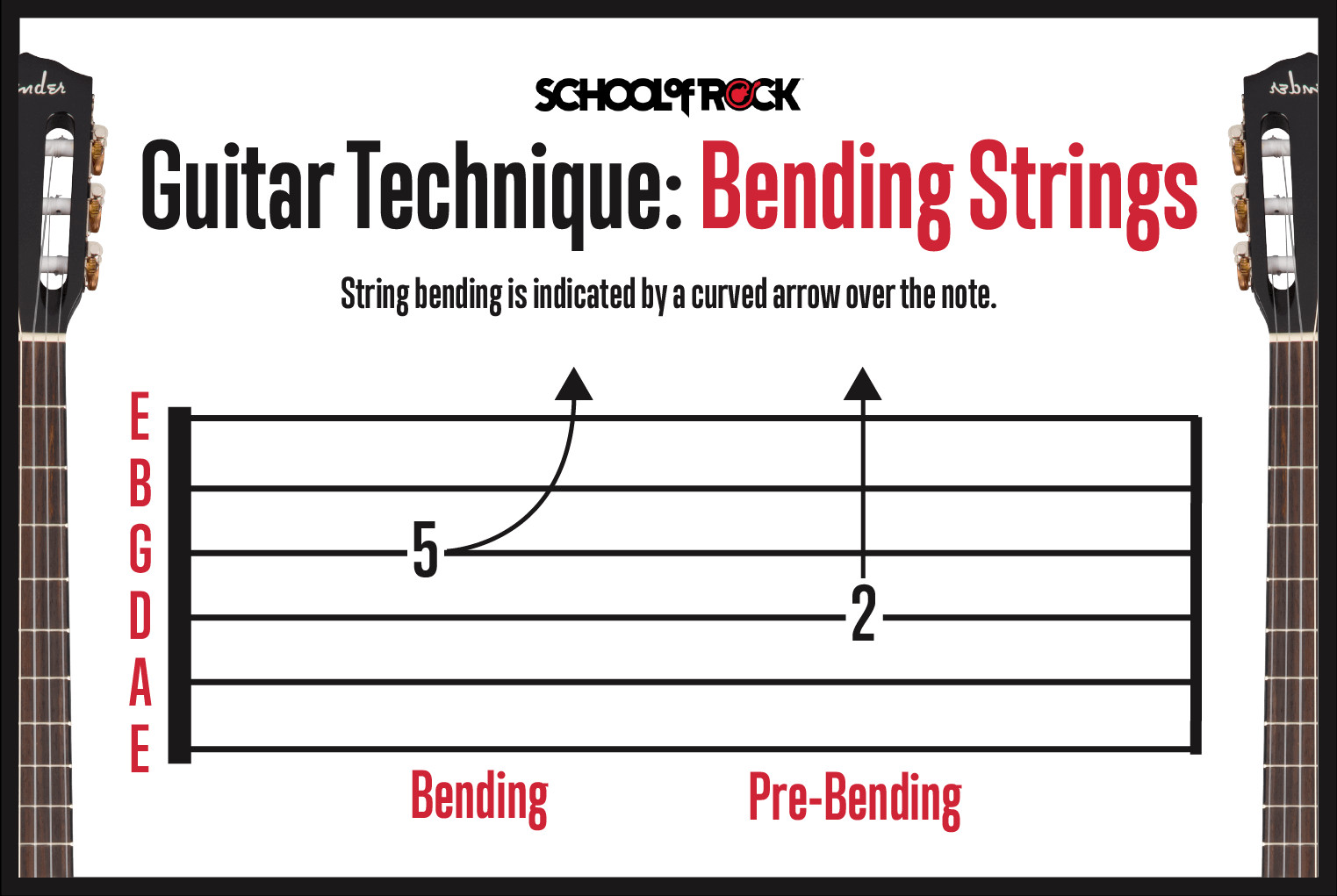 Guitar technique bending strings illustrated
Guitar technique bending strings illustrated
Pre-bending: Bending Before You Pick
When learning how to read guitar tabs, you might encounter “pre-bends.” In a pre-bend, the string is bent before it is picked. The tab notation for a pre-bend shows a straight upward arrow indicating the bend amount (e.g., “full,” “½”), followed by a curved arrow pointing downwards. After picking the pre-bent string, it can be released to return to its original pitch or bent further to another target note.
Sliding Guitar Notes: Seamless Transitions
Sliding is another essential guitar technique that creates smooth transitions between notes. You can slide up to a higher note or down to a lower note. Unlike bending, sliding involves moving your fretting finger along the fretboard to the next desired fret position.
Slide Up Technique
In guitar tabs, a slide up is represented by a line connecting the note you are sliding from to the note you are sliding to. If the target note is higher in pitch, the line will often slant slightly upwards.
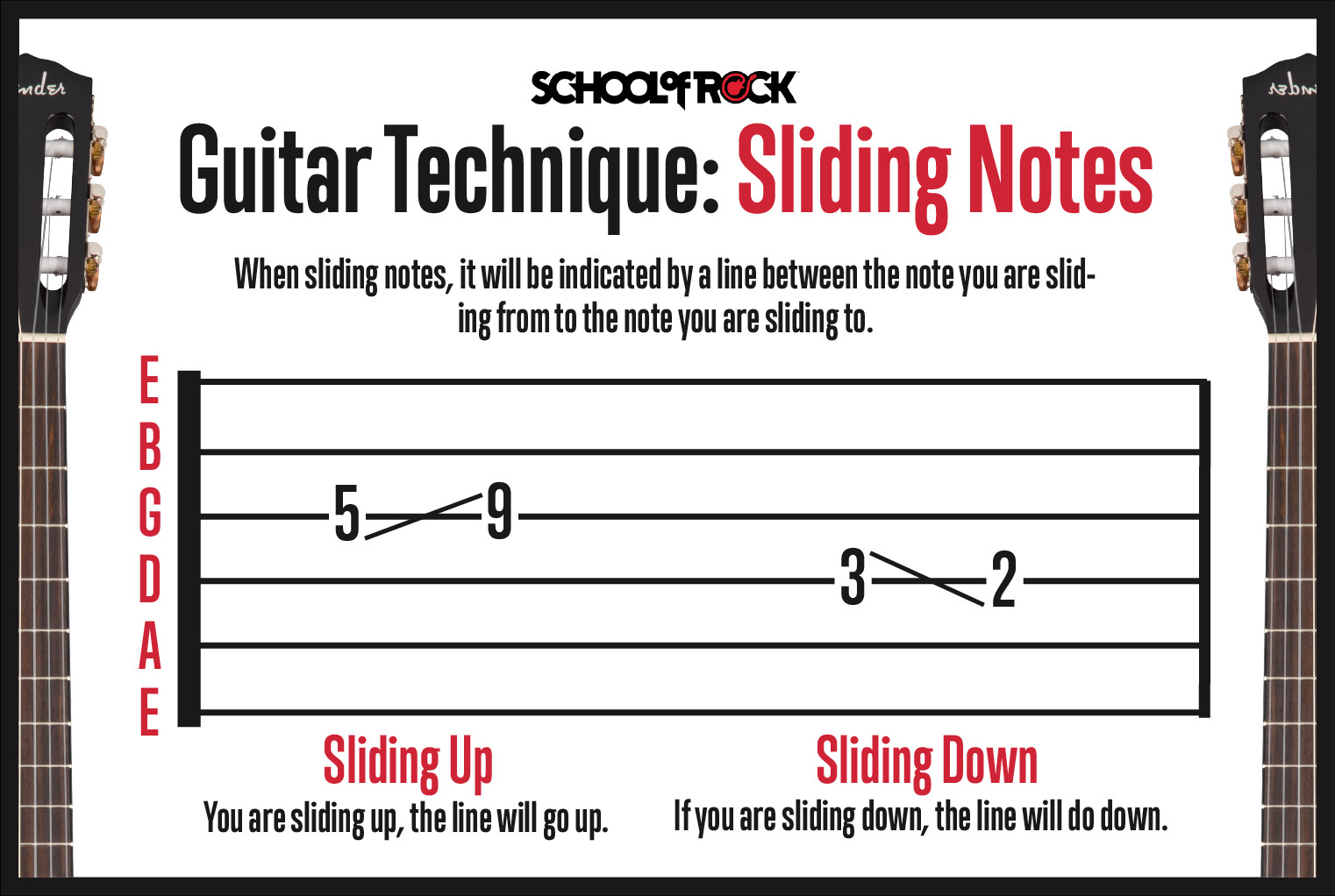 Guitar technique sliding notes example
Guitar technique sliding notes example
Slide Down Technique
Conversely, a slide down is shown by a line connecting the starting and ending notes, with the line often slanting slightly downwards if the target note is lower in pitch.
Hammer-ons (H): Articulating Notes with a Hammer
The hammer-on is a technique where you articulate a note not by picking it, but by “hammering on” to the string with a finger of your fretting hand. You can hammer-on from an open string or from a previously fretted note, and the resulting note will always be higher in pitch. In guitar tabs, hammer-ons are indicated by the letter “H” and an arc connecting either an open string or a fretted note to the hammered-on note.
How to Perform Hammer-ons
To play a hammer-on, strike the guitar string with your fretting finger with enough force to cause the string to vibrate and sound clearly. This requires a bit of practice to achieve a strong, clean note. Hammer-ons are generally easier to execute on electric guitars, especially at higher volumes. A good starting exercise is to play an open low E string and then hammer-on to the 3rd fret with your index finger, holding the note to let it ring. Repeat this exercise on different strings and frets to develop your technique.
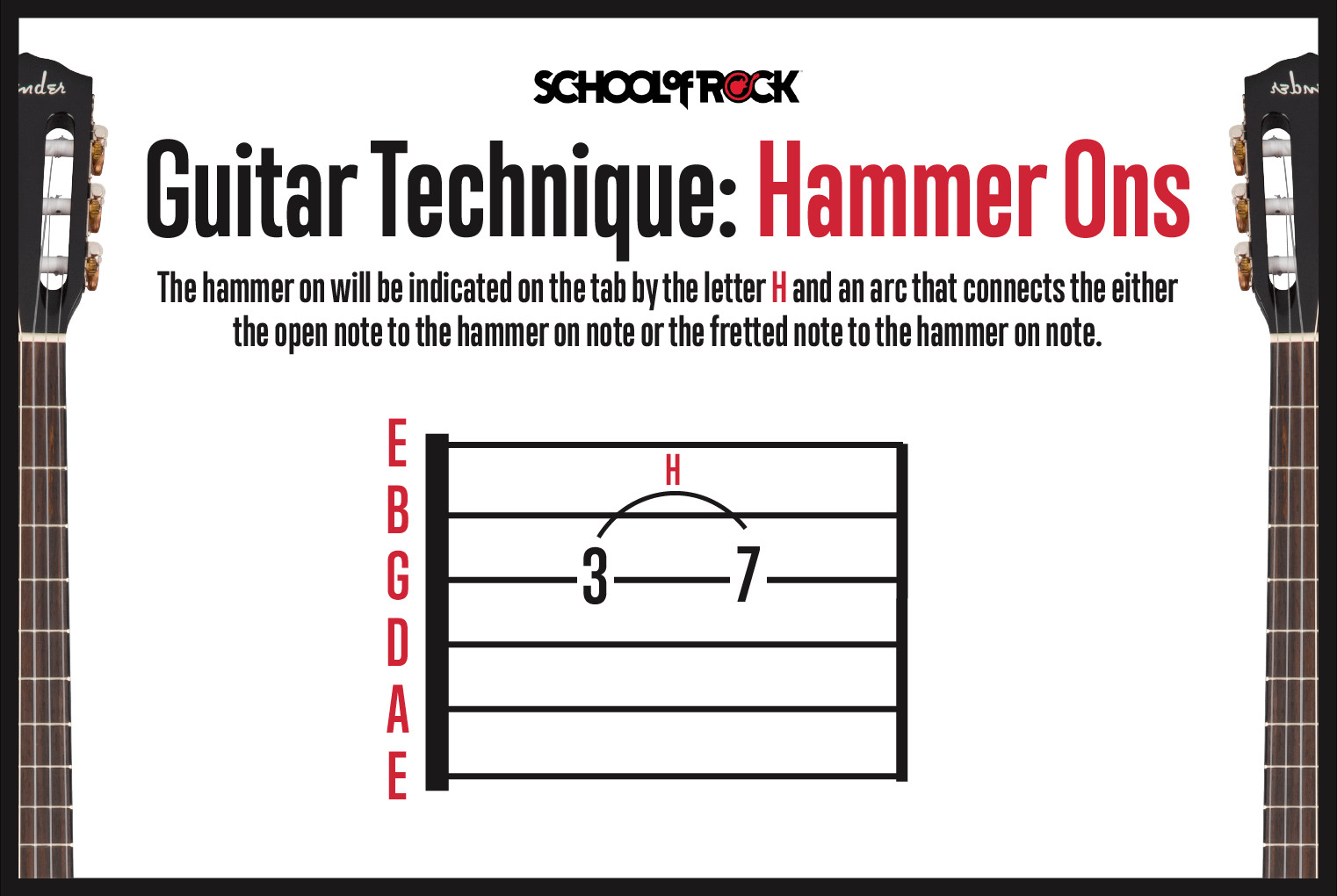 Guitar technique hammer-ons demonstration
Guitar technique hammer-ons demonstration
Pull-offs (P): Creating Notes by Pulling Away
Pull-offs are the opposite of hammer-ons. Instead of hammering onto a string, you “pull off” a fretted string to sound either an open string or a lower fretted note. In guitar tabs, pull-offs are indicated by the letter “P” and an arc connecting the pulled-off note to the resulting lower note.
How to Execute Pull-offs
To perform a pull-off, fret a note and then, using a downward or sideways motion, pull your fretting finger off the string. This action should pluck the string sufficiently to sound the next desired note, which will be lower in pitch. When playing pull-offs, ensure you “grab” enough of the string with your fingertip to create a clear sound as you pull away.
Hammer-ons and pull-offs can be combined in alternating sequences to create rapid note passages, sometimes referred to as “trills.”
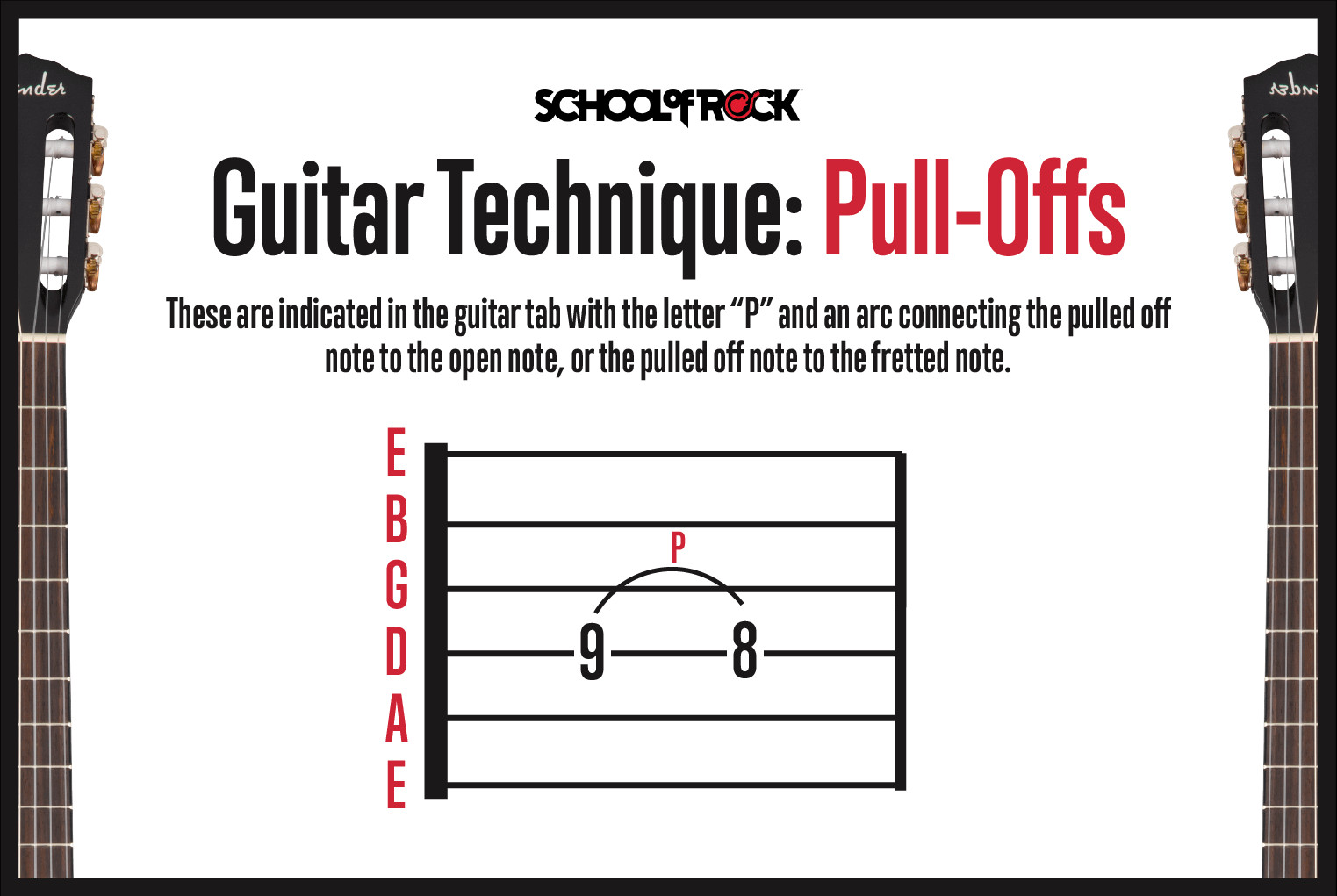 Guitar technique pull-offs illustrated
Guitar technique pull-offs illustrated
Vibrato: Adding Emotion and Sustain
Vibrato is a technique that adds warmth, emotion, and sustain to notes. It involves repeatedly and subtly bending a note up and down in pitch without fully releasing the fretted note. Vibrato is shown in guitar tabs as a zig-zag line above the staff. When learning how to read guitar tablature, note the length of the vibrato line. Generally, a longer line indicates a longer duration of vibrato.
How to Apply Vibrato
Vibrato is similar to bending but with a smaller pitch variation and a rhythmic pulsing quality. You can apply vibrato using a single finger or by using a main finger supported by others. Start by practicing slow, smooth vibrato and gradually vary the speed to achieve different expressive effects. Like bending, vibrato is a very personal technique, and each guitarist develops a unique vibrato style.
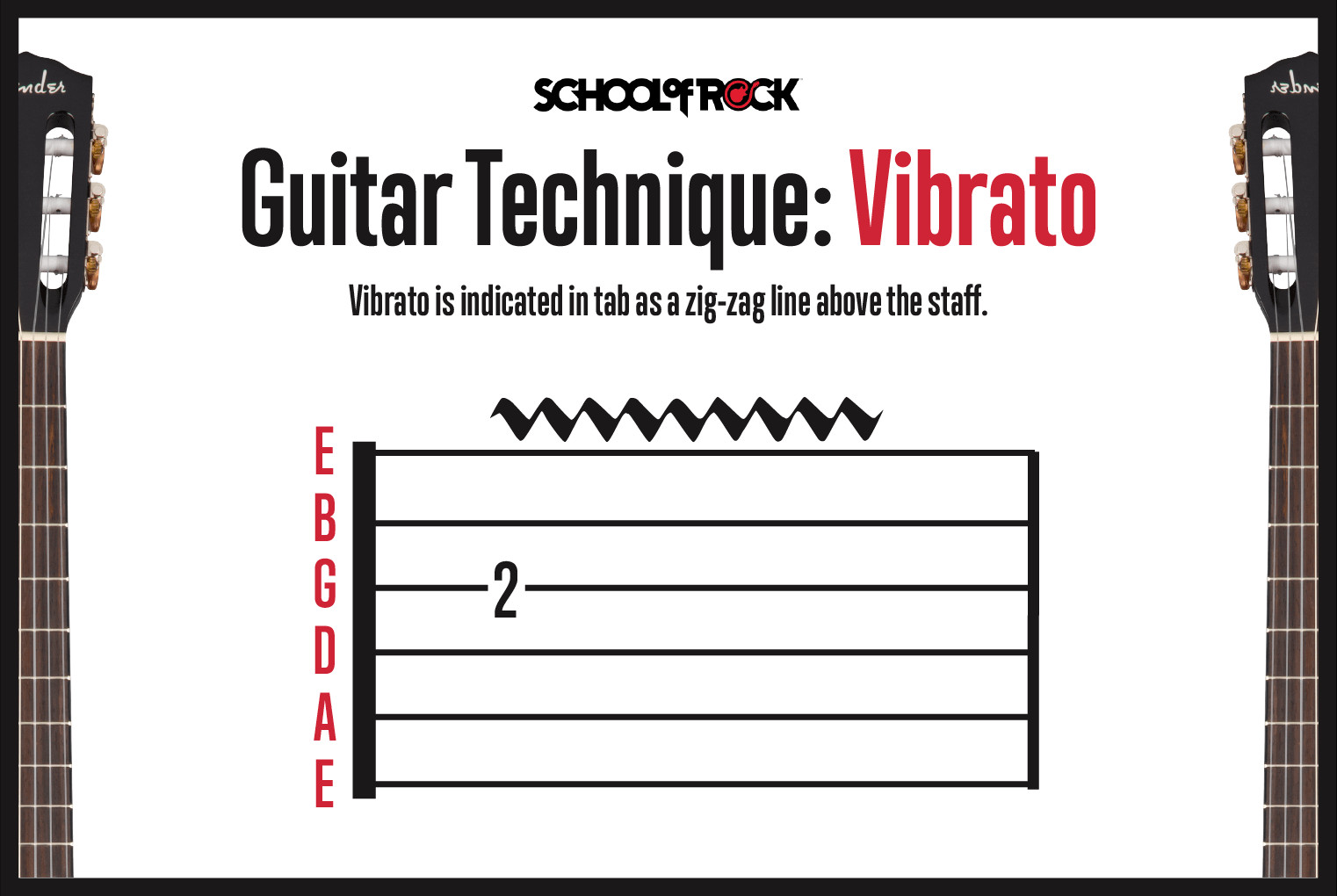 Guitar technique vibrato demonstration
Guitar technique vibrato demonstration
Tapping (T): Two-Handed Fretboard Artistry
Tapping is a technique where you fret notes with your regular fretting hand and also “tap” notes on the fretboard using a finger from your picking hand. The tapping action of the picking hand is essentially a variation of a hammer-on. In guitar tabs, tapping is notated by the letter “T” above the tapped note.
How to Finger Tap
Tapping was popularized by Eddie Van Halen, although the technique has roots in classical guitar. To finger tap, fret a note with your regular fretting hand and then “tap” a higher note on the same string using your picking hand’s index finger (or another finger).
Finger tapping is analogous to a hammer-on, but instead of using a finger from your fretting hand, you use a finger from your picking hand. This allows you to play notes with wide intervals that would be impossible to reach with just your fretting hand. Playing with overdrive or distortion and at a decent volume often makes tapping easier and more effective. Tapping also enables very fast playing as you are effectively using both hands to fret notes.
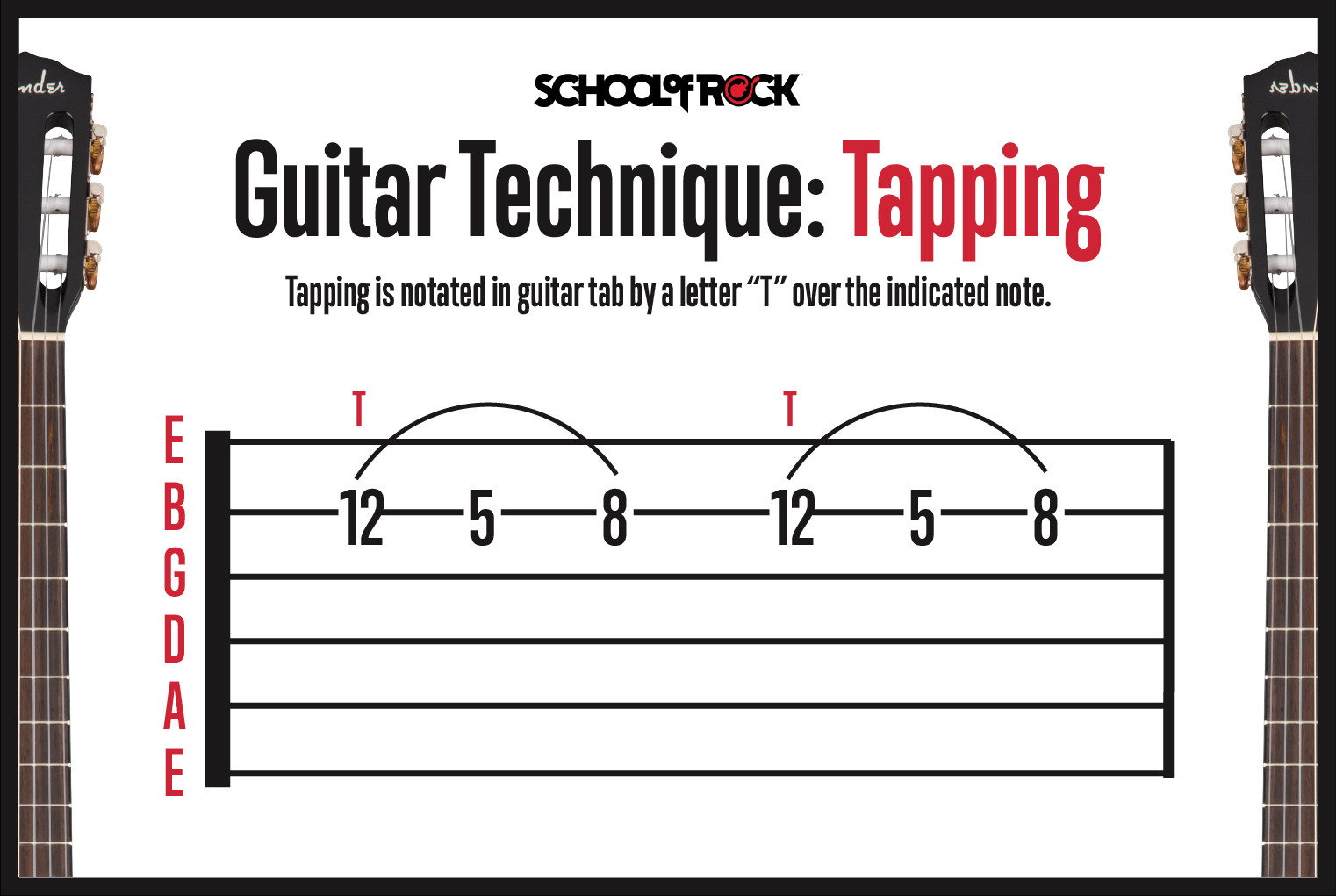 Guitar technique tapping notes illustrated
Guitar technique tapping notes illustrated
Two-Handed Tapping: Independent Lines
Two-handed tapping, as the name suggests, involves both hands independently tapping notes on the fretboard without traditional picking. To achieve this, both the fretting and picking hands hammer-on notes. Sometimes, this is used to play bass notes with the fretting hand while simultaneously tapping melody or solo lines with the picking hand.
Strumming Guitar Notes: Rhythm and Groove
When strumming chords on guitar, two basic strumming directions are used: downstrokes and upstrokes.
Downstrokes are played from the lower strings (thicker strings) to the higher strings (thinner strings) in a downward motion. In guitar tabs, downstrokes are represented by a symbol resembling a thick horizontal line with two short “legs” pointing downwards on each side.
Upstrokes are the opposite. They are played from the higher strings to the lower strings using an upward motion. Upstrokes in guitar tablature are notated by a “V” shaped symbol.
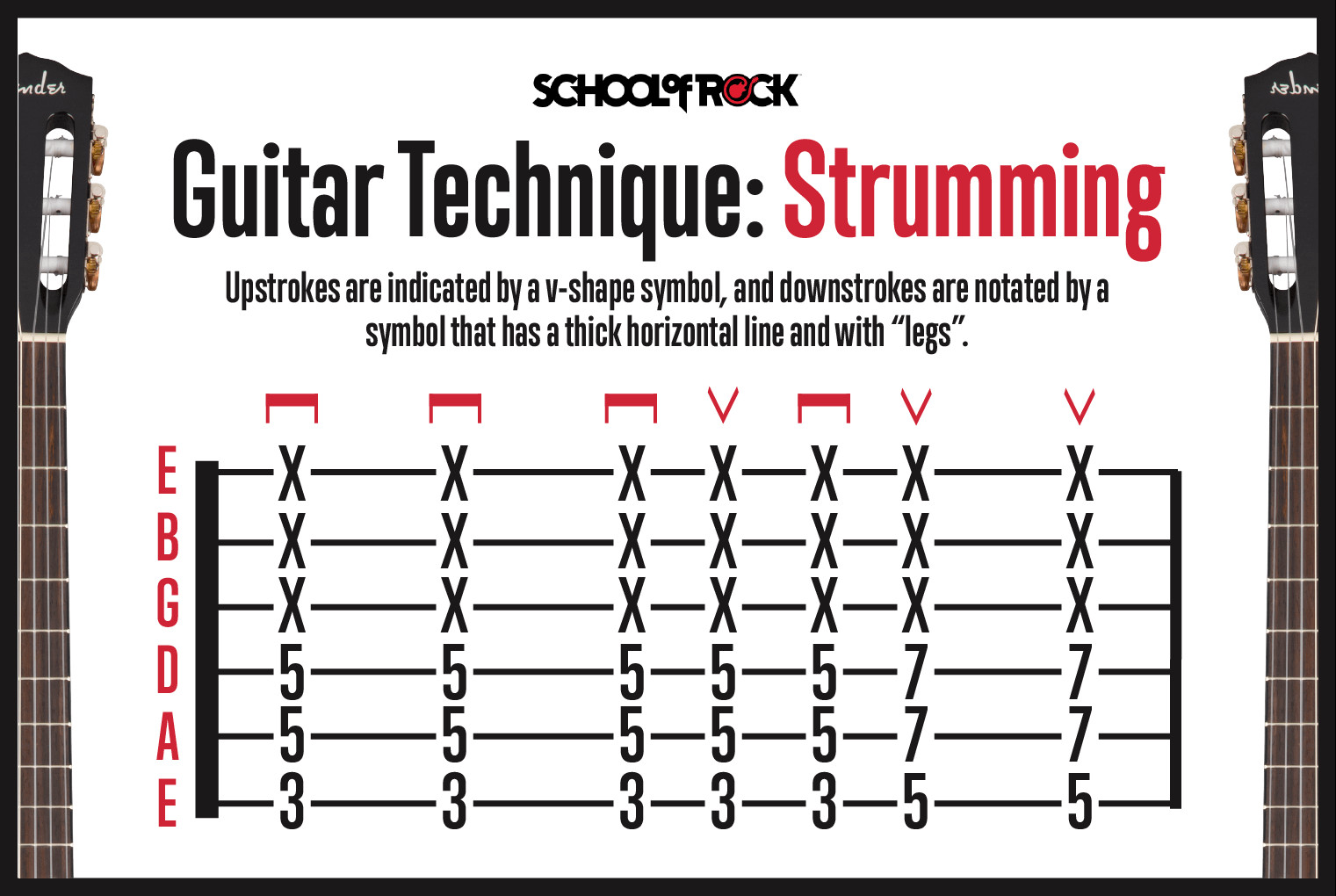 Guitar technique strumming patterns
Guitar technique strumming patterns
Mastering Strumming Patterns
When playing chords, various strumming patterns are used depending on the song’s rhythm. You can strum using a constant downstroke pattern, an alternating downstroke-upstroke pattern, or more complex combinations. Songs with an eighth-note rhythm are often counted as “one and two and three and four and…” Many songs utilize alternating upstrokes and downstrokes in an eighth-note rhythm, with downstrokes typically falling on the numbered beats (1, 2, 3, 4) and upstrokes on the “ands.”
Upstrokes and Downstrokes for Single Notes
The same upstroke and downstroke notation applies when playing single notes in guitar tabs. A downstroke symbol indicates picking the note with a downward motion of the pick, while an upstroke symbol (V) above the note indicates an upward pick motion.
Ready to Explore More Guitar Techniques?
Now that you’ve learned the fundamentals of reading guitar tabs and the various guitar techniques they represent, you’re well-equipped to start playing a vast range of music. From beginner-friendly strumming to advanced techniques like tapping, guitarplayers.net is here to support your musical journey.
Ready to find some guitar tabs and put your knowledge into practice? From simple songs for beginners to challenging pieces for experienced players, there’s a world of music waiting for you. For a vast and growing library of high-quality sheet music, check out Sheet Music Direct.
Thinking about getting a new guitar? Make sure to read our comprehensive Guitar Buying Guide before you make your purchase!
